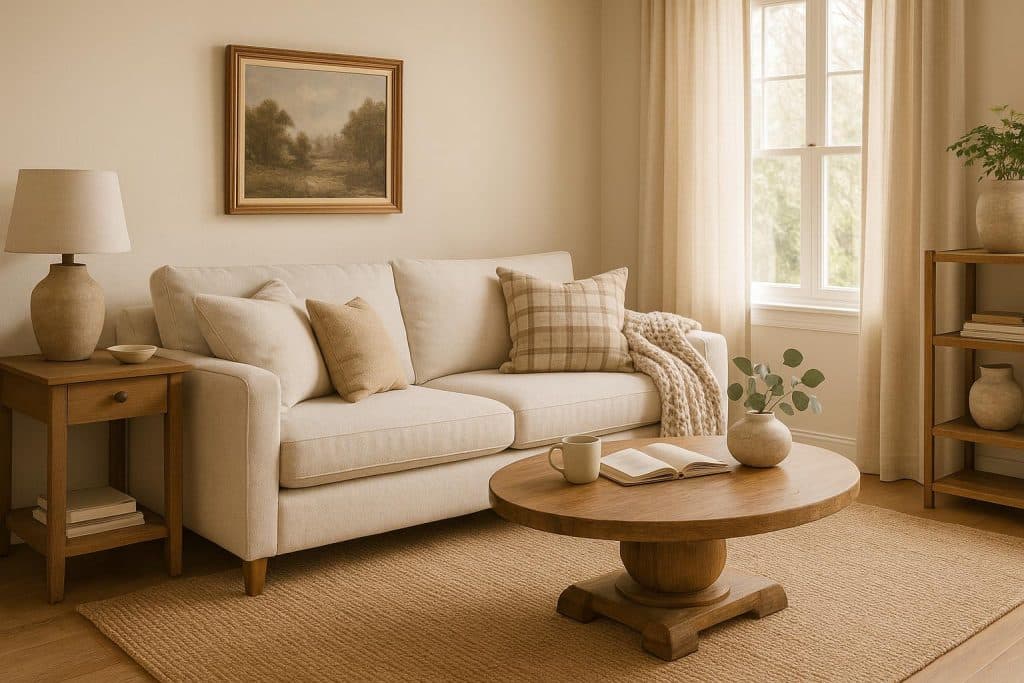A cozy living room doesn’t have to mean oversized furniture or cluttered spaces. It’s all about achieving warmth and comfort through the right balance of materials, colour, and layout.
With a few simple design choices, you can create a space that feels both inviting and visually refined – the kind of room that looks good and feels even better.
Key Takeaways
- Layering textures and tones adds instant warmth to any room.
- Lighting plays a major role in creating atmosphere and comfort.
- You can achieve a cozy, elegant feel without overdecorating.
1. Start With a Warm Colour Palette
The easiest way to make a room feel cozy is through colour. Warm tones such as beige, tan, olive, and terracotta naturally make a space feel more inviting. You don’t need to repaint the entire room – even adding soft neutrals through throws, cushions, and rugs can make a big difference.
If your space already features cooler shades like grey or white, balance them with warm accessories. Wooden accents, brass lighting fixtures, or textured fabrics help neutral spaces feel less sterile and more layered.
Colour doesn’t have to be loud to be effective – subtle warmth is often the key to coziness.
2. Focus on Texture and Material
Texture has a huge impact on how comfortable a room feels. A mix of smooth and tactile materials adds depth and softness, creating that “lived-in” warmth that’s hard to fake.
Combine fabrics like linen, wool, and velvet to achieve a multidimensional look. Add texture through small touches – a chunky knit throw, a boucle armchair, or a jute rug. Each layer contributes to a space that feels both stylish and comfortable.
You can find endless inspiration for mixing materials and furniture styles in online communities like FurnitureFaves, where homeowners share how they use texture and tone to elevate simple living spaces. Seeing how different materials interact in real homes often makes it easier to find your own ideal combination.
3. Balance Furniture Placement
Comfort isn’t just about how furniture feels – it’s about how it’s arranged. A well-balanced layout helps a room feel open and harmonious while maintaining intimacy.
Start with your largest piece of furniture, usually the sofa, and position it where it anchors the space naturally. Add armchairs or side tables to frame it, and leave enough room for movement between pieces. Avoid pushing everything against the walls – pulling furniture slightly inward creates a more inviting, conversational flow.
If you’re unsure about spacing, imagine how people will use the room. A good layout encourages connection without feeling crowded.
4. Lighting Sets the Mood
Lighting can make or break a cozy atmosphere. The goal is to create layers of light that shift with the time of day. Combine ambient lighting (like ceiling fixtures) with task lighting (such as reading lamps) and accent lighting (for mood or highlighting artwork).
Warm light tones can give your space a soft, golden glow. Dimmable bulbs let you adjust brightness for different moments – bright during the day and soft in the evening.
Don’t underestimate the effect of candles or soft-glow lamps, either. Small light sources add personality and intimacy to your setup.
5. Choose the Right Fabrics and Finishes
Fabrics and finishes are EVERYTHING when it comes to making your space feel cozy.
Opt for visible texture where possible.
For instance, a linen or chenille sofa feels softer and more approachable than a tight leather finish. Pairing it with woven cushions or a wool rug adds that extra tactile warmth. If you love modern design but want to avoid cold minimalism, these small details make all the difference.
Durability is another factor worth considering – especially in rooms where you relax the most. Fabrics that feel good and age gracefully are worth the investment.
6. Wrapping It Up
Creating a cozy living room isn’t about adding more things – it’s about adding the right things. Every material, colour, and light source should work together to make the space feel harmonious and welcoming.
Start with warm tones, layer your textures, and think carefully about how furniture placement affects the room’s flow. Once you have the foundation right, it’s the small personal touches – a soft rug, a textured throw, or warm lighting – that bring everything together.
